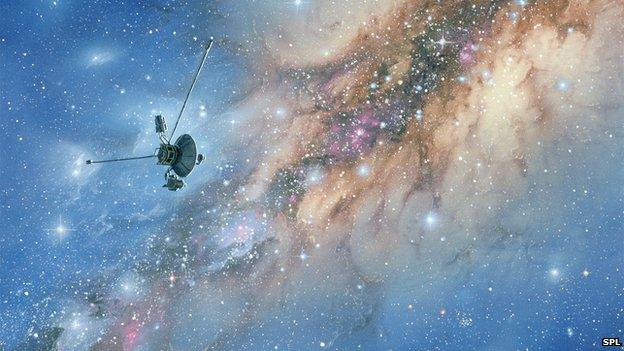Voyager Solar System 'exit' debated
- Published

An artist's impression of Voyager 1 as it passes across the Milky Way
The possibility that the Voyager-1 spacecraft may have left the Solar System is being hotly debated.
Launched in September 1977, the probe was sent initially to study the outer planets, but then just kept on going.
Researchers studying its data say the craft appears now to be in a realm of space beyond the influence of our Sun.
But the US space agency (Nasa), which manages Voyager, says that it regards the probe as still being inside the Solar System.
The mission is currently moving more than 18 billion km from Earth, or 123 times the distance between our planet and the Sun.
The latest research is published online in the journal Geophysical Research Letters (GRL).
It concerns data the spacecraft has been gathering about changes in its environment which for some time now have suggested it is about to cross over the Solar System's border - the so-called heliopause.
Cosmic ray detection
It has been detecting a rise in the number of high-energy particles, or cosmic rays, coming towards it from interstellar space, while at the same time recording a decline in the intensity of energetic particles coming from behind, from our Sun.
A big change occurred on 25 August last year, which the GRL paper's authors say was like a "heliocliff".
"Within just a few days, the heliospheric intensity of trapped radiation decreased, and the cosmic ray intensity went up as you would expect if it exited the heliosphere," explained Prof Bill Webber from New Mexico State University in Las Cruces.
Nasa funded the study but said any assessment that Voyager might be in interstellar space did not reflect the view of everyone working on the project, and Prof Weber acknowledges there is an ongoing debate about the probe's status.
Many researchers would like a long period with the data all pointing in one direction before calling the exit definitive.
"It's outside the normal heliosphere, I would say that," Prof Webber said in a release from the American Geophysical Union, publishers of GRL.
"We're in a new region. And everything we're measuring is different and exciting."
The Voyager project scientist at Nasa's Jet Propulsion Laboratory, Ed Stone, said he wanted to see a reorientation of the magnetic fields around the probe before declaring it to be in interstellar space. This was a "critical marker", he added. "…that change of direction has not yet been observed."
Voyager-1 was launched on 5 September 1977, and its sister spacecraft, Voyager-2, on 20 August 1977.
The probes' initial goal was to survey the outer planets Jupiter, Saturn, Uranus and Neptune - a task they completed in 1989.
They were then despatched towards deep space, in the general direction of the centre of our Milky Way Galaxy.
Their plutonium power sources will stop generating electricity in about 10-15 years, at which point their instruments and transmitters will die.
Voyager-1 is on course to approach a star called AC +793888, but it will only get to within two light-years of it and it will be tens of thousands of years before it does so.
Dallas Campbell describes the 35-year journey of Nasa's twin Voyager spacecraft
This page was updated following clarifications issued by both the AGU, the GRL publishers, and Nasa.
- Published15 June 2012
- Published26 February 2013